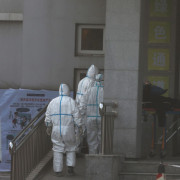Coronavirus statistics
Содержание:
Objects and Surfaces
The virus could spread by touching an object or surface with virus present from an infected person, and then touching the mouth, nose or eyes.
Surface contamination as observed in the study cited above :
- Computer mouse (ICU 6/8, 75%; GW 1/5, 20%)
- Trash cans (ICU 3/5, 60%; GW 0/8)
- Sickbed handrails (ICU 6/14, 42.9%; GW 0/12)
- Doorknobs (GW 1/12, 8.3%)
76.5% of all personal items sampled at the University of Nebraska Medical Center (UNMC) were determined to be positive for SARS-CoV-2
Of these samples, 81.3% of the miscellaneous personal items were positive by PCR, which included:
- Exercise equipment
- Medical equipment (spirometer, pulse oximeter, nasal cannula)
- PC and iPads
-
Reading glasses
Other findings: - Cellular phones (83.3% positive for viral RNA)
- Remote controls for in-room TVs (64.7% percent positive)
- Toilets (81.0% positive)
- Room surfaces (80.4% of all sampled)
- Bedside tables and bed rails (75.0%)
- Window ledges (81.8%)
Duration of contamination on objects and surfaces
Although the virus titer was greatly reduced, viable SARS-CoV-2 was measured for this length of time:
- Plastic: up to 2-3 days
- Stainless Steel: up to 2-3 days
- Cardboard: up to 1 day
- Copper: up to 4 hours
Patients Under Investigation (PUI) in the United States
CDC in the early stages released information regarding the number of cases and people under investigation that was updated regularly on Mondays, Wednesdays, and Fridays. Below we provide the historical reports that we were able to gather in order to track the progression in the number of suspected cases and US states involved through time in the initial stages
As of Feb. 10:
| Number of U.S. States with PUI | 36 |
| Positive | 12 |
| Negative | 318 |
| Pending(specimens awaiting testing) | 68 |
| TOTAL | 398 |
As of Feb. 7:
| Number of U.S. States with PUI | 36 |
| Positive | 12 |
| Negative | 225 |
| Pending(specimens awaiting testing) | 100 |
| TOTAL | 337 |
As of Feb. 5:
| Number of U.S. States with PUI | 36 |
| Positive | 11 |
| Negative | 206 |
| Pending(specimens awaiting testing) | 76 |
| TOTAL | 293 |
As of Feb. 3:
| Number of U.S. States with PUI | 36 |
| Positive | 11 |
| Negative | 167 |
| Pending(specimens awaiting testing) | 82 |
| TOTAL | 260 |
As of January 31:
| Number of U.S. States with PUI | 36 |
| Positive | 6 |
| Negative | 114 |
| Pending(specimens awaiting testing) | 121 |
| TOTAL | 241 |
Previously, as of January 29, there were 92 suspected cases awaiting testing.
| Number of U.S. States with PUI | 36 |
| Positive | 5 |
| Negative | 68 |
| Pending(specimens awaiting testing) | 92 |
| TOTAL | 165 |
Patients Under Investigation (PUI) in the United States
CDC in the early stages released information regarding the number of cases and people under investigation that was updated regularly on Mondays, Wednesdays, and Fridays. Below we provide the historical reports that we were able to gather in order to track the progression in the number of suspected cases and US states involved through time in the initial stages
As of Feb. 10:
| Number of U.S. States with PUI | 36 |
| Positive | 12 |
| Negative | 318 |
| Pending(specimens awaiting testing) | 68 |
| TOTAL | 398 |
As of Feb. 7:
| Number of U.S. States with PUI | 36 |
| Positive | 12 |
| Negative | 225 |
| Pending(specimens awaiting testing) | 100 |
| TOTAL | 337 |
As of Feb. 5:
| Number of U.S. States with PUI | 36 |
| Positive | 11 |
| Negative | 206 |
| Pending(specimens awaiting testing) | 76 |
| TOTAL | 293 |
As of Feb. 3:
| Number of U.S. States with PUI | 36 |
| Positive | 11 |
| Negative | 167 |
| Pending(specimens awaiting testing) | 82 |
| TOTAL | 260 |
As of January 31:
| Number of U.S. States with PUI | 36 |
| Positive | 6 |
| Negative | 114 |
| Pending(specimens awaiting testing) | 121 |
| TOTAL | 241 |
Previously, as of January 29, there were 92 suspected cases awaiting testing.
| Number of U.S. States with PUI | 36 |
| Positive | 5 |
| Negative | 68 |
| Pending(specimens awaiting testing) | 92 |
| TOTAL | 165 |
Sources
- Symptoms of Novel Coronavirus (2019-nCoV) — United States Centers for Disease Control and Prevention (CDC)
- Clinical Characteristics of 138 Hospitalized Patients With 2019 Novel Coronavirus–Infected Pneumonia in Wuhan, China — JAMA, Wang et al., February 7, 2020
- Clinical features of patients infected with 2019 novel coronavirus in Wuhan, China — Huang et al., The Lancet. January 24, 2020
- Epidemiological and clinical characteristics of 99 cases of 2019 novel coronavirus pneumonia in Wuhan, China: a descriptive study — Chen et al, The Lancet, January 30, 2020
- Report of the WHO-China Joint Mission on Coronavirus Disease 2019 (COVID-19) — World Health Organization, Feb. 28, 2020
Статистика развития пандемии коронавируса Covid-19 в России
На 23 декабря 2020 в России зафиксировано 2 933 753 случая заражения коронавирусом Covid-19. За последние сутки число зараженных выросло на 27 250 человек.Общее число смертей от коронавирусной инфекции в России составляет 52 461 человек, сегодня зафиксировано 549 случаев смерти.В активной фазе болезни находятся 537 325 человек, из них 2 300 в критическом состоянии. Уровень летальности: 1.79%.Подтвержденных случаев полного излечения от вируса на сегодня, 23 декабря 2020 в России: 2 343 967.
На графике представлены значения подтвержденных случаев заражения коронавирусом Covid-19 в России по дням от начала сбора официальной статистической информации.
* Нулевые значения означают отсутствие данных
Timeline of Events
-
On January 31, HHS declared Coronavirus a Public Health Emergency in the US
As of Jan. 31, the Wuhan coronavirus is officially a public health emergency in the United States, Alex Azar, secretary of the US Department of Health and Human Services (HHS), announced at a White House press briefing. - On Jan. 31, the U.S. Centers for Disease Control and Prevention (CDC) issued a federal quarantine for 14 days affecting the 195 American evacuees from Wuhan, China. Starting Sunday, Feb. 2, U.S. citizens, permanent residents and immediate family who have visited China’s Hubei province will undergo a mandatory 14 days quarantine and, if they have visited other parts of China, they would be screened at airports and asked to self-quarantine for 14 days. The last time the CDC had issued a quarantine was over 50 years ago in the 1960s, for smallpox.
- President Donald Trump signed an order on Jan. 31 for the U.S. to deny entry to foreign nationals who traveled to China within the preceding two weeks, aside from the immediate family of U.S. citizens.
- On Jan. 30, the CDC had confirmed the first case of person to person transmission in the U.S.: [] the husband of the Chicago, Illinois case who had returned from Wuhan, China on Jan. 13 and who tested positive for the virus on Jan. 24).
- CDC stated on Jan. 30 that «It is likely there will be more cases of 2019-nCoV reported in the U.S. in the coming days and weeks, including more person-to-person spread.»[]
- The virus had been confirmed in 5 states.
- On Jan. 31, New York City health officials vehemently denied the rumor regarding a coronavirus case in the city .[]. On Feb. 1, however, the city’s health commissioner did report that there was a test being performed on a person under 40 who had returned from China, developed matching symptoms, and tested negative to the seasonal flu.
- Most US patients had recently visited Wuhan.
- All of the first five U.S. cases were described as mild.
- A study on the first US case of novel coronavirus detailed mild symptoms followed by pneumonia
U.S. Airlines suspended ALL flights between the U.S. and China
On Friday, January 31, Delta, American and United announced they would temporarily suspend all of their mainland China flights in response to the coronavirus outbreak.[]
Prior to this January 31 announcement:
-
UNITED AIRLINES
on Jan. 28 had announced it would cut 24 flights between the U.S. and China for the first week of February. -
AMERICAN AIRLINES
on Jan. 29 had announced it would suspend flights from Los Angeles to Shanghai and Beijing from Feb. 9 through March 27, 2020. It will maintain its flight schedules (10 daily A/R) from Dallas-Fort Worth to Shanghai and Beijing, as well as from Los Angeles and Dallas-Fort Worth to Hong Kong. - DELTA had not adjusted its schedule of direct flights from the U.S. to China. It is the only airline with direct flights to not take action so far.
[]
Travel Alert: Do Not Travel to China
- The U.S. State Department on January 30 issued a Level 4: Do Not Travel to China Alert [] (the highest level of alert).
- Previously, on January 29, the advisory was set at a lower «Level 3: Reconsider Travel» advising not to travel to Hubei Province: (Level 4) and reconsider travel to the remainder of China (Level 3).
- The CDC on Jan. 28 issued a Level 3 Warning, recommending that travelers avoid all nonessential travel to China [].
Screening incoming passengers at 20 airports in the U.S.
On January 17, the CDC announced that 3 airports in the United States would begin screening incoming passengers from China: SFO, JFK, and LAX [] Other 2 airports were added subsequently, and on January 28, the U.S. Department of Health and Human Services (HHS) announced that 15 additional U.S. airports (bringing the total to 20) would begin screening incoming travelers from China.
Below is the complete list of airports where screening for the 2019 Novel Coronavirus (2019-nCoV) is in place:
- Los Angeles International (LAX)
- San Francisco International (SFO)
- Chicago O’Hare
- New York JFK
- Atlanta Hartsfield-Jackson International
- Houston George Bush Intercontinental
- Dallas-Fort Worth International
- San Diego International
- Seattle-Tacoma International
- Honolulu International
- Anchorage Ted Stevens International
- Minneapolis-St. Paul International
- Detroit Metropolitan
- Miami International
- Washington Dulles International
- Philadelphia International
- Newark Liberty International
- Boston Logan International
- El Paso International
- Puerto Rico’s San Juan Airport
Timeline of Events
-
On January 31, HHS declared Coronavirus a Public Health Emergency in the US
As of Jan. 31, the Wuhan coronavirus is officially a public health emergency in the United States, Alex Azar, secretary of the US Department of Health and Human Services (HHS), announced at a White House press briefing. - On Jan. 31, the U.S. Centers for Disease Control and Prevention (CDC) issued a federal quarantine for 14 days affecting the 195 American evacuees from Wuhan, China. Starting Sunday, Feb. 2, U.S. citizens, permanent residents and immediate family who have visited China’s Hubei province will undergo a mandatory 14 days quarantine and, if they have visited other parts of China, they would be screened at airports and asked to self-quarantine for 14 days. The last time the CDC had issued a quarantine was over 50 years ago in the 1960s, for smallpox.
- President Donald Trump signed an order on Jan. 31 for the U.S. to deny entry to foreign nationals who traveled to China within the preceding two weeks, aside from the immediate family of U.S. citizens.
- On Jan. 30, the CDC had confirmed the first case of person to person transmission in the U.S.: [] the husband of the Chicago, Illinois case who had returned from Wuhan, China on Jan. 13 and who tested positive for the virus on Jan. 24).
- CDC stated on Jan. 30 that «It is likely there will be more cases of 2019-nCoV reported in the U.S. in the coming days and weeks, including more person-to-person spread.»[]
- The virus had been confirmed in 5 states.
- On Jan. 31, New York City health officials vehemently denied the rumor regarding a coronavirus case in the city .[]. On Feb. 1, however, the city’s health commissioner did report that there was a test being performed on a person under 40 who had returned from China, developed matching symptoms, and tested negative to the seasonal flu.
- Most US patients had recently visited Wuhan.
- All of the first five U.S. cases were described as mild.
- A study on the first US case of novel coronavirus detailed mild symptoms followed by pneumonia
U.S. Airlines suspended ALL flights between the U.S. and China
On Friday, January 31, Delta, American and United announced they would temporarily suspend all of their mainland China flights in response to the coronavirus outbreak.[]
Prior to this January 31 announcement:
-
UNITED AIRLINES
on Jan. 28 had announced it would cut 24 flights between the U.S. and China for the first week of February. -
AMERICAN AIRLINES
on Jan. 29 had announced it would suspend flights from Los Angeles to Shanghai and Beijing from Feb. 9 through March 27, 2020. It will maintain its flight schedules (10 daily A/R) from Dallas-Fort Worth to Shanghai and Beijing, as well as from Los Angeles and Dallas-Fort Worth to Hong Kong. - DELTA had not adjusted its schedule of direct flights from the U.S. to China. It is the only airline with direct flights to not take action so far.
[]
Travel Alert: Do Not Travel to China
- The U.S. State Department on January 30 issued a Level 4: Do Not Travel to China Alert [] (the highest level of alert).
- Previously, on January 29, the advisory was set at a lower «Level 3: Reconsider Travel» advising not to travel to Hubei Province: (Level 4) and reconsider travel to the remainder of China (Level 3).
- The CDC on Jan. 28 issued a Level 3 Warning, recommending that travelers avoid all nonessential travel to China [].
Screening incoming passengers at 20 airports in the U.S.
On January 17, the CDC announced that 3 airports in the United States would begin screening incoming passengers from China: SFO, JFK, and LAX [] Other 2 airports were added subsequently, and on January 28, the U.S. Department of Health and Human Services (HHS) announced that 15 additional U.S. airports (bringing the total to 20) would begin screening incoming travelers from China.
Below is the complete list of airports where screening for the 2019 Novel Coronavirus (2019-nCoV) is in place:
- Los Angeles International (LAX)
- San Francisco International (SFO)
- Chicago O’Hare
- New York JFK
- Atlanta Hartsfield-Jackson International
- Houston George Bush Intercontinental
- Dallas-Fort Worth International
- San Diego International
- Seattle-Tacoma International
- Honolulu International
- Anchorage Ted Stevens International
- Minneapolis-St. Paul International
- Detroit Metropolitan
- Miami International
- Washington Dulles International
- Philadelphia International
- Newark Liberty International
- Boston Logan International
- El Paso International
- Puerto Rico’s San Juan Airport






